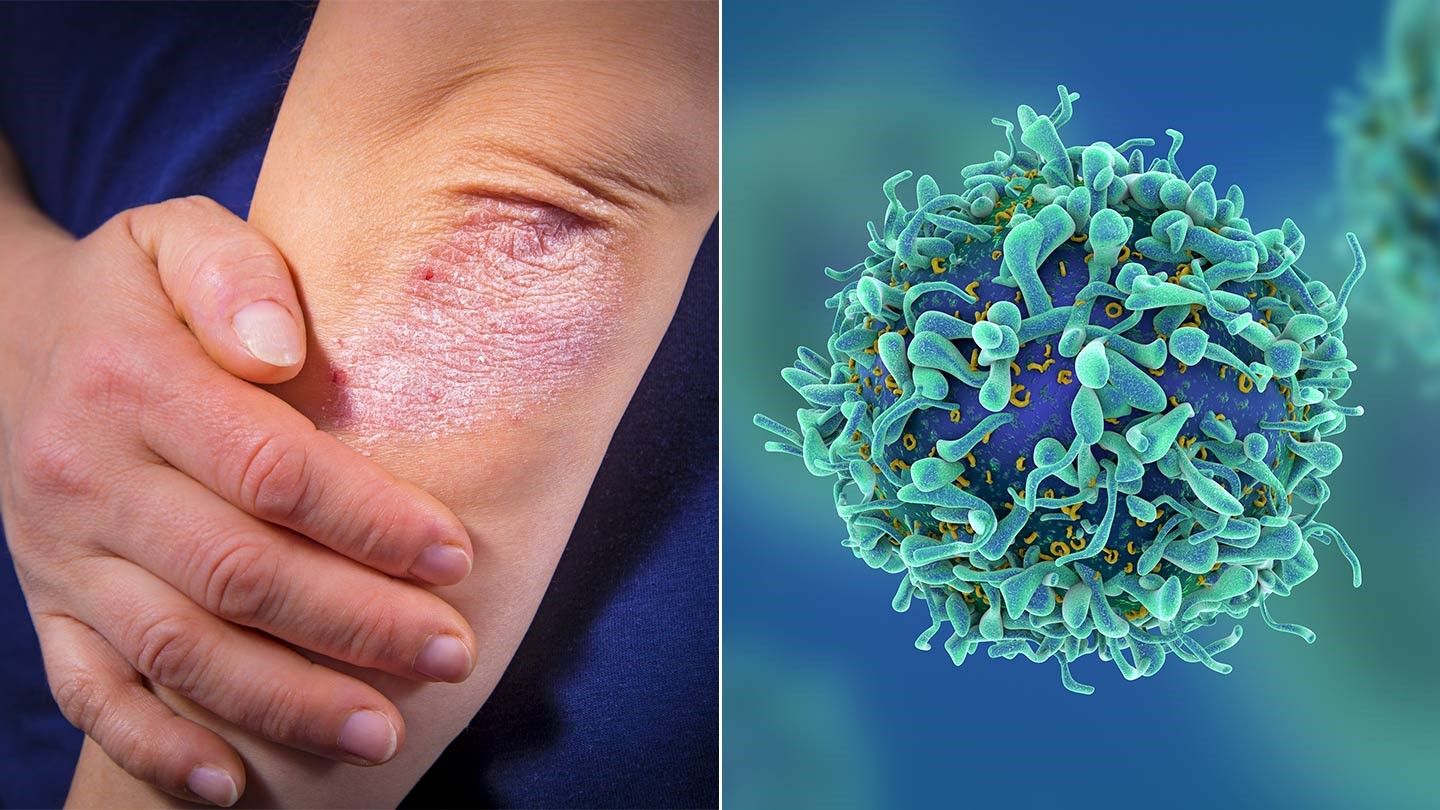Skin cancer is far and away the most common cancer in the United States, affecting an estimated one in five Americans by the age of 70. (1)
Skin cancer is the rampant growth of abnormal skin cells. The cause is usually excessive exposure to ultraviolet (UV) radiation, either from sunlight or indoor tanning devices.
UV radiation can damage the DNA of skin cells, resulting in mutations (genetic defects). These mutations instruct the abnormal skin cells to multiply at a rapid pace, forming malignant tumors. (2)
Basal cell carcinoma and squamous cell carcinoma, the most common types of skin cancer, tend to develop on parts of the body that get a lot of sun exposure, such as the face, ears, neck, lips, and the backs of the hands.
A history of serious sunburns can also raise skin cancer risk.
Melanoma is much less prevalent than other types of skin cancer but more dangerous. It, too, is typically related to overexposure to UV radiation, but appears to be more strongly linked to genetic factors than other types of skin cancer. (3)
Three Types of Skin Cells That Can Become Malignant
To understand skin cancer, you need a basic understanding of skin cells. There are three main types in the epidermis (the top layer of skin), all of which have the potential to become malignant.
- Squamous Cells These flat cells are in the outer part of the epidermis. The body continually sloughs off old squamous cells as it makes new ones.
- Basal Cells Located in the lower part of the epidermis, basal cells constantly divide, flattening as they move up in the skin (toward the surface) to become new squamous cells.
- Melanocytes These cells produce melanin, a pigment that gives skin its brown or tan color. They act as a natural sunscreen, helping protect layers of skin below the epidermis from UV damage.
Most Common Skin Cancers
There are three main categories of skin cancer as well as a number of rare kinds.
- Basal Cell Carcinoma This cancer accounts for about 80 percent of all cases of skin cancer. It is almost always completely curable, rarely spreading to other parts of the body. Left untreated, however, it can destroy skin, deep tissue, and bone, becoming disfiguring or causing functional problems.
- Squamous Cell Carcinoma Accounting for about 20 percent of all skin cancers, this carcinoma is also highly treatable. However, it is more likely than basal cell carcinoma to spread. Although metastatic squamous cell cancer is uncommon, it can be life-threatening.
- Melanoma This form of cancer, which develops in the melanocytes, makes up only about 1 percent of all skin cancers. As with basal and squamous cell carcinomas, it is very curable if diagnosed early. If it is not treated quickly, however, it is more likely than these other skin cancers to metastasize and can prove fatal. (4)
Rare Types of Skin Cancer
The following diseases make up less than 1 percent of all skin cancers.
- Merkel cell carcinoma This cancer develops in cells found at the base of the epidermis, close to nerve endings. It is very aggressive, with a high risk of metastasizing. (5)
- Kaposi sarcoma (KS) A cancer of the cells that line lymph or blood vessels, KS appears as lesions on the skin, inside the mouth, or elsewhere in the body. In the United States, the most common type of KS develops in people who have the HIV virus. (6)
- Cutaneous (skin) lymphoma This cancer starts in white blood cells, called lymphocytes, in the skin. (7)
- Skin adnexal tumors These cancers start in hair follicles or skin glands.
- Various types of sarcomas
How Prevalent Is Skin Cancer?
It’s estimated that in the United States, more than 3.3 million people are diagnosed and treated each year for 5.4 million basal cell and squamous cell carcinomas. (These numbers are for 2012, the most recent year for which data is available.)
The number of people in the United States who will receive a melanoma diagnosis in 2018 is estimated to be 178,560.
In a troubling trend, the incidence of all types of cancers has been going up for years.
Researchers have found that the number of people receiving a diagnosis of basal cell carcinoma more than doubled between the time spans between 1976–1984 and 2000–2010.
The incidence of squamous cell carcinoma shot up 263 percent over the same periods.
Women had the greatest jump for both basal cell and squamous cell carcinomas, with people age 40 and below also showing a disproportionate increase. (1)
Melanoma rates are also rising at an alarming pace. From 2008 to 2018, the number of new cases diagnosed annually increased by 53 percent.
The unwavering popularity of indoor tanning beds among young white women may help explain these numbers.
Researchers believe that indoor tanning devices may be responsible for more than 419,000 cases of skin cancer in the United States each year: 245,000 basal cell carcinomas, 168,000 squamous cell carcinomas, and 6,200 melanomas. (8)
So You’ve Had Skin Cancer. Now What?
Melanoma survivors may well be expected to be alert for a recurrence, but anyone who’s had any type of skin cancer should remain extra vigilant.
This entails being scrupulous about scheduling follow-up visits to the dermatologist (or oncologist), conducting frequent skin self-exams, and limiting UV exposure.
If not removed completely, basal cell carcinoma can grow back on the same place on the skin. People who have had basal cell cancer are at higher risk of developing it again in other areas of the skin, too. (4)
People with squamous cell carcinoma are also at increased risk for recurrence, especially in the same skin area or nearby. Growths on the nose, ears, and lips pose the highest risks. (9)
Studies also suggest that people with basal or squamous cell cancers are at increased risk of developing another type of cancer, particularly melanoma. For women, this risk also includes breast and lung cancer. (10)
Skin Cancer: What Are the Risk Factors?


How Psoriasis and Cancer May Be Linked
If you want to lower your risk of skin cancer, the smartest thing you can do is to minimize your exposure to ultraviolet (UV) rays. Experts blame UV rays for 90 percent of basal cell and squamous cell carcinomas and (according to one study) 86 percent of melanomas. Both the UV rays produced by sunlight and those created by indoor tanning devices damage the DNA of skin cells, creating genetic mutations that prompt those cells to multiply wildly and form tumors. Certain physical characteristics can make you especially vulnerable to the harmful effects of UV rays, such as fair skin; blue, green, or gray eyes; and blond, red, or light-brown hair.
Learn More About Causes and Risk Factors
Types of Skin Cancer: Do You Know What They Are?


Does IBD Put You at Greater Risk of Skin Cancer?
There are three main categories of skin cancer, each affecting a different type of skin cell. Basal cell cancer is the kind you’re most likely to get, accounting for around 80 percent of all skin carcinomas. This cancer grows slowly and is extremely unlikely to spread. If left untreated, however, it can become disfiguring or lead to functional problems. Squamous cell cancer accounts for roughly 20 percent of all skin cancers. It’s more likely to spread than basal cell cancer, but the overall risk remains very low. Melanoma is the least common skin cancer, accounting for less than 1 percent of all skin cancers, but the most likely to spread and to become life-threatening.
Learn More About the Types of Skin Cancer
What is Melanoma?
Melanoma is, by far, the most deadly type of skin cancer. It is most often a result of exposure to ultraviolet (UV) rays— whether from the sun, sun lamps, or tanning beds . A melanoma often looks like a mole. It is usually black or brown but it can also be skin-colored, purple, blue, red, pink, or white.
Learn More About Melanoma
Skin Cancer Symptoms: Spot Them Early


6 Home Remedies to Soothe a Sunburn
Some skin cancers closely resemble normal skin or a harmless mole, but there can also be signs of danger. One red flag for basal cell and squamous cell carcinoma is an open sore that repeatedly bleeds and crusts. These cancers could also look like a pink bump with raised edges and a depression in the center; or they can resemble pink, reddish, or brown patches that lie flat against the skin. Melanoma, the most dangerous cancer, has subtle differences that can help distinguish it from a benign mole: It might be asymmetrical, for instance, or have notched edges instead of smooth ones. Knowing these differences — and conducting regular skin checks to identify suspicious growths — can lead to early detection and the best possible outcome after treatment.
Learn More About the Signs and Symptoms of Skin Cancer
Skin Cancer Treatment: Which One is Right for You?


Rheumatoid Arthritis Medication: Beware of Sunburn if You Take These Drugs
If you have skin cancer, the treatment you’ll get will depend on a number of things, starting with the type of cancer and its severity. Surgery — usually outpatient, under local anesthesia — is often the first step. For a small, superficial, low-risk basal cell carcinoma, a dermatologist might scrape off the tumor using a device called a curette. A bigger or trickier cancer might call for Mohs surgery, during which the doctor methodically removes the cancer layer by layer, examining each under a microscope for any stray cancer cells. Excisional surgery, in which the doctor uses a scalpel to remove the entire tumor as well as a margin of healthy skin around it, may be the best choice for many patients, with newer techniques resulting in smaller scars.
Learn More About Skin Cancer Treatment
Help Navigating a Skin Cancer Diagnosis


How to Prevent and Treat 8 Common Skin Problems
Most skin cancers are not life-threatening and not cause for alarm, but you do need to learn about the condition and what your options are, and you still might want to find a network of support to lead you through the maze of treatment and aftercare. Here are our favorite resources.
Learn More About Where to Find Skin Cancer Help
Resources We Love
Favorite Orgs for Skin Cancer
Skin Cancer Foundation
In addition to providing information about skin cancer prevention, detection, and treatment, the Skin Cancer Foundation’s website has a section called True Stories, where patients share their cancer journeys.
American Academy of Dermatology
The AAD offers information on various types of skin conditions, including skin cancer. We love that their free resources page provides simple, educational handouts that cover topics like how to select a sunscreen, how to spot a cancerous mole, and more.
American Cancer Society
The American Cancer Society is a long-time trusted source for cancer information and resources. One cool feature is their Skin Cancer Quiz, which lets you test your knowledge about this common cancer.
Favorite Online Support and Advocacy Networks
National Council on Skin Cancer Prevention
This organization offers information on preventing skin cancer and what to do if you’re diagnosed. We love that their Get Involved section has easy ways for you to become an advocate and even write to your Congress rep.
Daily Strength
Daily Strength’s skin cancer online support groups are a great way to meet and connect with others who’ve been diagnosed with your same cancer.
Favorite App
SkinVision
Want to perform high-tech skin checks on your mobile device? With this app, you simply snap a picture of your skin spot, and SkinVision will give you a risk score within 30 seconds. So far, the app has identified more than 27,000 skin cancers.
Favorite Site for Products
Skin Cancer Foundation
The Skin Cancer Foundation gives certain products its “seal of recommendation” if they meet specific criteria for effective UV sun protection. You can search for the approved products, including cosmetics, moisturizers, and sunglasses, here.
Favorite Blogs
SkinCancer.Net
Get ready to read inspirational stories told by skin cancer survivors and their loved ones. An editorial team also provides informative blogs. You can easily subscribe to the blog to get the latest entries in your inbox.
Sun and Skin News
This blog, which is featured on the Skin Cancer Foundation’s website, includes true patient stories and other skin-related articles.
Favorite Annual Meetings
World Congress on Cancers of the Skin
Since 1983, the Congress has held this meeting, which allows physicians to learn about breakthrough discoveries on the prevention, diagnosis, and treatment of all types of skin cancer. The event is held in a different country every two years and is partly sponsored by the Skin Cancer Foundation.
American Academy of Dermatology Annual Meeting
The AAD’s annual meeting brings the brightest minds in dermatology together for a one-of-a-kind educational experience. The latest advances in dermatology, including skin cancer, are discussed in detail.


Editorial Sources and Fact-Checking
- Skin Cancer Stats and Facts. American Academy of Dermatology
- What Is Skin Cancer? The Skin Cancer Foundation
- Does UV Radiation Cause Cancer? American Cancer Society
- What Are Basal and Squamous Cell Skin Cancers? American Cancer Society
- Merkel Cell Skin Cancer. American Cancer Society
- Kaposi Sarcoma. American Cancer Society
- Lymphoma of the Skin. American Cancer Society
- Skin Cancer Facts and Statistics. The Skin Cancer Foundation
- Squamous Cell Cancer: Recurrence, Prevention, and Early Detection. The Skin Cancer Foundation
- Fengju Song et al., “Risk of a Second Primary Cancer after Non-Melanoma Skin Cancer in White Men and Women: A Prospective Cohort Study” (April 23, 2013). PLOS Medicine

































